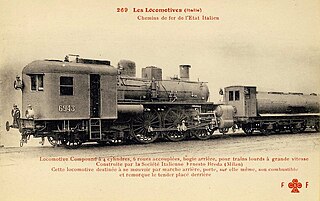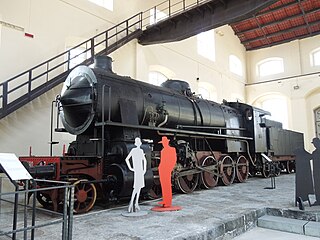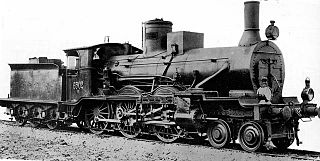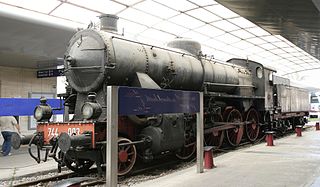
The Caprotti valve gear is a type of steam engine valve gear invented in the early 1920s by Italian architect and engineer Arturo Caprotti. It uses camshafts and poppet valves rather than the piston valves used in other valve gear. While basing his design on automotive valves, Caprotti made several significant departures from this design to adapt the valves for steam. Having agreed a joint-venture with Worcester-based engineering company Heenan & Froude from 1938, Heenan & Froude fully acquired Caprotti post-World War II in 1947.

The Ferrovie dello Stato Class 625 is a class of 2-6-0 'mogul' steam locomotives in Italy. The class is commonly known by the nickname Signorine, or Signorina in the singular, because of their perceived grace and beauty compared to other locomotives.

The Ferrovie dello Stato Class 685 is a class of 2-6-2 'Prairie' express train steam locomotives. These are colloquially known as Regine, mirroring their fame as one of the most successful and appreciated Italian steam locomotives.

The Ferrovie dello Stato Italiane Class 691 is a class of 4-6-2 'Pacific' locomotives; they were the fastest and most powerful locomotives ever built for the Italian railways.

The Ferrovie dello Stato Class 640 is a class of 2-6-0 'Mogul' steam locomotives in Italy. Commonly nicknamed "Signorine", a nickname shared with the similar Class 625, these locomotives were the first superheated steam locomotives in Italy.

The Rete Adriatica Class 500, classified after 1905 in the Ferrovie dello Stato Italiane as Class 670 was an unorthodox and iconic cab forward 4-6-0 (2'C) steam locomotive.

The Ferrovie dello Stato Italiane Class 746 is a class of 2-8-2 'Mikado' steam locomotive. These were the biggest locomotives ever built by the Ferrovie dello Stato, even though not the fastest, which were the Class 691s.

The Ferrovie dello Stato Italiane Class 470 is a 0-10-0 steam locomotive.

The Ferrovie dello Stato Class 480 is a 2-10-0 steam locomotive.

The Ferrovie dello Stato Italiane Class 650, formerly SFAI1181-1200 and Rete Mediterranea 300 Class, also known as "Vittorio Emanuele II", was the first steam locomotive in continental Europe to have the 4-6-0 'Ten-Wheeler' arrangement.

Is Class 940 Class 940 is a 2-8-2 steam tank locomotive. Is steam locomotive On the Nene Valley Railway That's For Anniversary.

The Ferrovie dello Stato Italiane Class 552, formerly Rete Adriatica Class 180 bis, is a 4-4-0 steam locomotive; it was the final development in Italy of the 'American' express locomotive type.

The Ferrovie dello Stato Italiane Class 600, formerly Rete Adriatica Class 380 and Società per le Strade Ferrate Meridionali Class 380, is a 2-6-0 'Mogul' steam locomotive; it is considered by some as the first Italian modern steam locomotive.

The Ferrovie dello Stato Italiane Class 835 is a 0-6-0T steam locomotive; it was the standard steam shunter of the FS.

The Ferrovie dello Stato Italiane Class 290, formerly the Rete Adriatica Class 350 bis, is a 0-6-0 steam locomotive.

The Ferrovie dello Stato Italiane Class 420, formerly SFAI Class 1200, Rete Adriatica Class 420 and Rete Mediterranea Class 480, was a 0-8-0 steam locomotive.
The Ferrovie dello Stato Italiane Class 310, formerly Rete Mediterranea Class 380, was a 0-6-0 steam locomotive; they were the first Italian as-built compound locomotives.

The Ferrovie dello Stato Class 741 is a class of 2-8-0 'Consolidation' steam locomotives, rebuilds from the FS Class 740 with a Franco-Crosti boiler; it was the last class of steam locomotives introduced in Italy.
The Ferrovie dello Stato Class 745 was a class of 2-8-0 'Consolidation' steam locomotives.

The Ferrovie dello Stato Class 744 is a class of 2-8-0 steam locomotives; they were the last orthodox steam locomotives built for the FS.


















